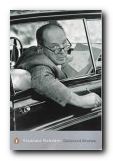a critical examination of Nabokov’s collected stories
The work of Vladimir Nabokov as a writer of short stories falls into what for the sake of convenience can be called three separate periods. During the first – the 1920s – he was developing his reputation as an émigré author living in Berlin, writing poetry, plays, reviews, film scripts, and novels as well as stories whilst supporting himself by giving lessons in tennis and English.
 During the second – the 1930s – having established that reputation with his early novels written in Russian, he produced what are probably his finest stories. Towards the end of the decade however, he was forced to move to Paris and then to America where, feeling that he had lost his audience of the post-1917 Russian emigration, he began writing in English.
During the second – the 1930s – having established that reputation with his early novels written in Russian, he produced what are probably his finest stories. Towards the end of the decade however, he was forced to move to Paris and then to America where, feeling that he had lost his audience of the post-1917 Russian emigration, he began writing in English.
During the final period – the 1940s – he produced only a few more stories, and following the establishment of his international reputation as a novelist with the publication of Lolita in 1955, he effectively stopped writing short fictions from that time.
It is the purpose of this study to trace the development of his skill in the creation of short fictions through the whole of his fifty published stories, and in particular to examine his manipulation of traditional narrative modes.
Nabokov offers readers a challenging instance of multi-cultural influences. He was, to quote his own description of himself, “An American writer, born in Russia and educated in England, where [he] studied French literature before spending fifteen years in Germany” (SO,p.26). The fact that he actually lived in all those countries and absorbed their cultures through both daily life and their literary heritage makes the task of fully appreciating his work difficult enough; but when added to this one confronts the fact that he thought, spoke, and wrote in Russian, French, and English (though not, through personal antipathy, German) the task can become even more daunting. As George Steiner has observed:
“this polylinguistic matrix is the determining fact of Nabokov’s life and art … To be specific: the multilingual, cross linguistic situation is both the matter and form of Nabokov’s work” (Steiner,p.18).
A Note on Sources
There are no critical editions of Nabokov’s work. His short stories first appeared in Russian émigré newspapers and magazines published in Germany in the 1920s and 1930s. Some stories were later collected and published in volume form in Berlin and Paris in the 1930s. Following his emigration to the USA he began to publish stories in The New Yorker and The Atlantic Monthly, and there was a collection in volume form in 1958 – Nabokov’s Dozen.
However, some of the stories exist in two and sometimes three versions. Quite apart from the fact that the earlier stories were written in Russian and the later ones in English, the process of translating the earlier works has variously involved other people, Nabokov himself, or Nabokov in collaboration with others. And at each stage of translation or re-publication of his work Nabokov was much given to polishing and embellishment of what he had written, which usually resulted in additional layers of linguistic complexity.
It is significant in this respect that there have already been several attempts to establish a bibliographical description of his work. Fortunately for the English speaking reader, Nabokov before his death managed to re-translate (in collaboration with his son, Dimitri) the bulk of his stories. These are now available along with his editorial prefaces and bibliographical notes, in the following English editions:
Nabokov’s Dozen, 1959
A Russian Beauty and Other Stories, 1973
Tyrants Destroyed and Other Stories , 1975
Details of a Sunset and Other Stories, 1976
In the Foreword to Details of a Sunset Nabokov offers his own bibliography with the remark “The collection is the last batch of my Russian stories meriting to be Englished” (DS,p.11) which lightly underlines the fact that other untranslated or uncollected stories do exist (some of them are paraphrased both in Andrew Field’s Nabokov: His Life in Art and in Brian Boyd’s biography Vladimir Nabokov: The Russian Years).
But until the literary archaeological work is done which will bring these stories into general circulation, both scholars and general readers alike have every reason to feel confident that the pieces in these four volumes represent Nabokov’s oeuvre, issued with his authority, as a writer of short stories. It is for this reason that they will be used here as basic sources, and reference made to them by the initials of their titles.
![]() Vladimir Nabokov: The Collected Stories – Amazon UK
Vladimir Nabokov: The Collected Stories – Amazon UK
![]() Vladimir Nabokov: The Collected Stories – Amazon US
Vladimir Nabokov: The Collected Stories – Amazon US
Vladimir Nabokov web links
Vladimir Nabokov greatest works
Vladimir Nabokov criticism
Vladimir Nabokov life and works